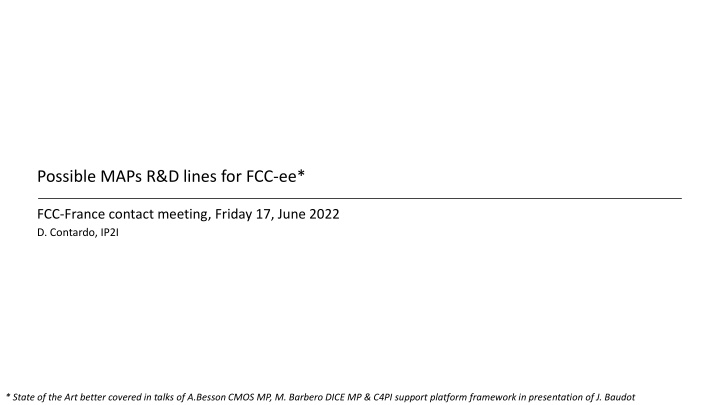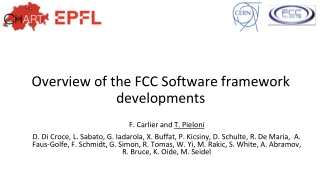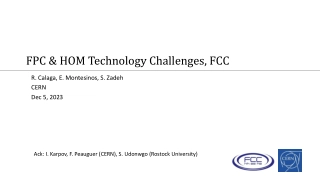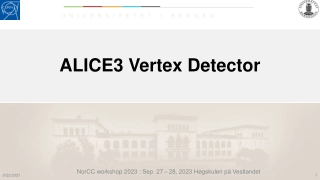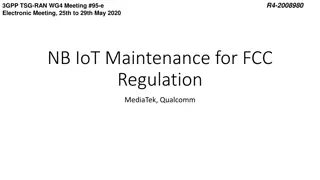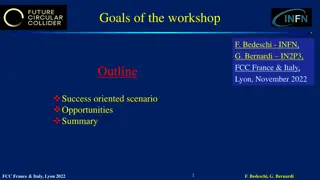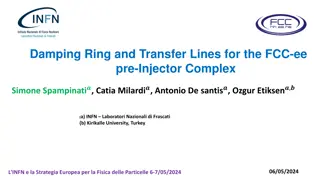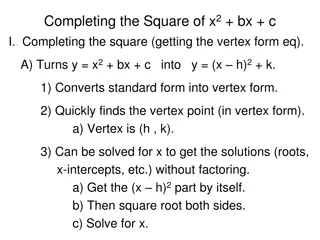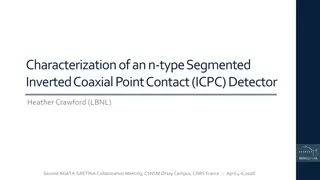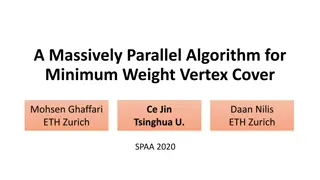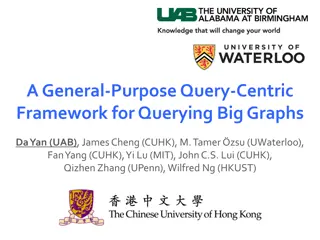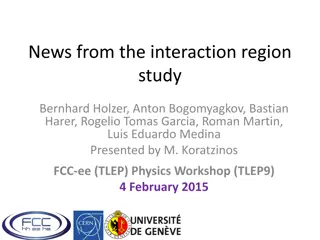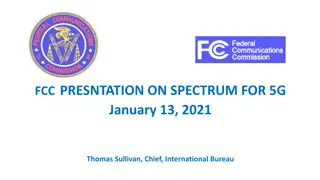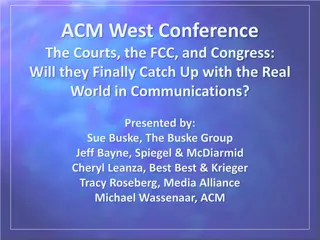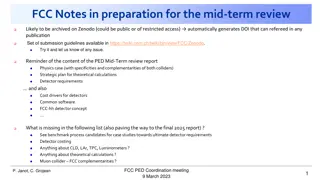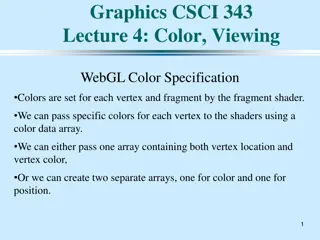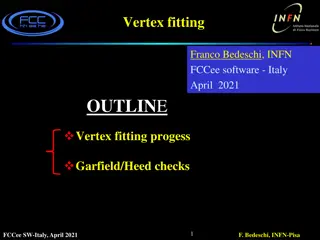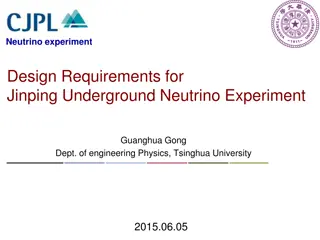Possible R&D Lines for FCC-ee Vertex and Detector Requirements
In preparation for the FCC-France contact meeting, this session will cover state-of-the-art developments in the field, focusing on the requirements for the Vertex Detector. Discussions will include studies on hit rates, integration times, power dissipation, and architecture simulation. Additionally, attention will be given to Central Tracker and HGCalo requirements, exploring advancements and implications for energy resolutions. The aim is to assess various parameters such as electrode size, pitch, and sensor configurations to optimize performance.
Download Presentation

Please find below an Image/Link to download the presentation.
The content on the website is provided AS IS for your information and personal use only. It may not be sold, licensed, or shared on other websites without obtaining consent from the author.If you encounter any issues during the download, it is possible that the publisher has removed the file from their server.
You are allowed to download the files provided on this website for personal or commercial use, subject to the condition that they are used lawfully. All files are the property of their respective owners.
The content on the website is provided AS IS for your information and personal use only. It may not be sold, licensed, or shared on other websites without obtaining consent from the author.
E N D
Presentation Transcript
Possible MAPs R&D lines for FCC-ee* FCC-France contact meeting, Friday 17, June 2022 D. Contardo, IP2I * State of the Art better covered in talks of A.Besson CMOS MP, M. Barbero DICE MP & C4PI support platform framework in presentation of J. Baudot
MAPs for Vertex Detector requirements (SoA) / studies Ballpark requirements* (SoA) hit 3 m (WP1.2 TJ 65 nm ER1/ER2 pitch 18 m - hit 5 m) Assuming binary readout (ToT could be a relatively low power consumption alternative) Large sensors 12 with stitching (main goal of WP1.2) Hit rate max 50 mHz/cm2 (WP1.2 ER1/ER2 ITS3 < 10 MHz/cm2) Integration time 1 s (FE speed matched) (covered in WP1.2 ER1/ER2) Low power dissipation O(20) mW/cm2 (MOSS (ALPIDE PE synchrone), MOST (MALTA-type asynchrone) in WP1.2 ER1 - not yet defined for ER2 but likely MOSS less risky for ITS3 schedule) (Central Tracker, HGCalo, Timing Layer) Also applying to other systems Studies Simulate physics/bgd for rates Prepare realistic event inputs for architecture simulation Study asymptotic effect of hit on d0/z (pT, ) - considering overall configuration, X/X0 Develop a parameterized model of power consumption scaling in matrix and periphery According to #channels & gemoetry (electrode size/capacitance), FE speed/noise, rates w/o and w/ precision timing ToA/ToT implementation Simulate/evaluate architecture options performance with physics/bgd simulation inputs 2 * Close to those proposed for ALICE-3 (2034-35) eg 2.5 m, 35 MHz/cm2 and 70 mW/cm2
MAPs for Central Tracker requirements (SoA) / studies Ballpark requirements (SoA is mostly from pixels) hit ( ) 5 m (achieved in pixels) - pitch can be relaxed in r-z Only ex. ? CLICTD 30 x 8 x 37.5 (300) m2 , a OR of 8 sub-pixels to ToA, ToT, 1stfiring pixel t O(ns) Large sensors 12 Hit rate tbd Integration time 1 s (FE speed matched) as for pixels Low power dissipation tbd Studies Simulate physics/bgd for rates Prepare realistic event inputs for architecture simulation Study asymptotic effect of hit on pT (pT, ) considering overall configuration, X/X0 Study electrode size and pitch (grouping in r-z) Develop a model of power consumption impact on cooling and overall X/X0 3 * In CLICTD a Or of 8 sub-pixels enters ToA, ToT (the timing is given by first pixel above threshold with t O(ns))
MAPs for HGCalo requirements(SoA) / studies Ballpark requirements* (SoA no specific MAPS developments so far) Pad (analog) / Pixel (counting)**, size/pitch tbd (5 x 5 mm2 for pads in current hybrid designs) Large sensors 12 Hit rate tbd Integration time 1 s as for pixels? FE speed according to t tbd Low power dissipation tbd Studies Benefit of MAPS for compactness Study effect of electrode pitch, size and active thickness on energy resolutions Including comparing pad analog vs pixel counting Study effect of power consumption / cooling on energy resolutions Study benefit of timing ns and sub-nanosecond Simulate physics/bgd for rates Prepare realistic event inputs for architecture simulation Simulate architecture according to physics/bgd simulations * To be covered by HGCalo community ** Amplitude can be provided by ToT if a timing feature is included 4
MAPs for Timing Layer requirement (SoA) / studies Ballpark requirements (SoA) Target 10 ps per hit (PID) ( 50 ps expected with 1 mm2 pads) 20 ps still of interest if 3 layers at large tracker radii? Studies t optimization versus electrode size, pitch, sensor thickness Implementation of ToA/ToT Granularity as a function of rates and subsequent power consumptions Opportunities to implement 3D or amplification in MAPS (current hybrid design alternatives) 5
Summary ballpark parameters for subsystem options Values are indicative, requiring simulation studies (see previous slides) and inputs from performance depending on sensor parameters (electrode pitch/size, active thivkness) Detector Sensor 12" Readout Performance Paramater Elect. Pitch ( m) Elec. Size ( m) Act. thick. Power ToA/T hit ( m) t (ps) 10 2 10 3 Vertex +++ NA NA 20 - 10001) 502) 20 - 1000 5 Central Tracker +++ NA NA Pads 10001) 1000 x 1000 500 ( 1000) HGCAL anal. Pads ++ (+) NA 50 x 50 50 500 10 HGCAL Digi. Pixels ++ (++) NA Pads 10001) 1000 x 1000 500 10 Timing Layer Pads + +++ NA 10 2 10 3 10 Timing Layer Pixels + +++ 1) 2) Could be small electrodes grouped for lower C? ex. to improve hit (cluster size with lower threshold) and t For X/X0 considering sensor bending 6
R&D options for FCC-ee Sensitive area a) Large area sensors with stitching all systems b) Small pitch, thin active layer for ultimate hit and t all systems c) Pads vs small electrode grouping for S/N, in thin/thick sensors for ultimate t CT, HGCalo, TL d) 3D or amplification designs for ultimate t all systems Readout e) Low power architecture adapted to FCC-ee rates all systems Readout concept, synchronous vs asynchronous Timing implementation FE and ToA/ToT FE O(25) ns for t O(1) ns for HGCalo - O(1) ns for t O(10) ps for Timing Layer(s) (possibly HGCalo) TDC possible implementation and granularity (depending on rates ) f) Investigate implementation in 3D integration These topics could be a basis of discussion to develop a common FCC-ee R&D program A mini-workshop organised in the C4PI plateform framework by October (see J. Baudot talk) will be an opprotuinity to identify possible common demonstrator developments with all groups* interested in MAPS developments 7 * Several expressions of interest in PEPR project (rejected) CPPM, IJCLab, IPHC, IP2I, IRFU, LLR, LP2I, LPNHE, LPSC, and also CEA/IRFU
R&D opportunities on short/medium term WP1.2 CERN - ER2 (timescale Oct. 2023) in TJ 65 nm Mainstream sensor: large size for ITS3 10 x 28 cm2 with stitching On-going contribution to design of FE, MOSS(PE) architecture (IPHC so far) Periphery components: 0.5 x 28 cm2 available on each side of mainstream sensor Could include follow-up of asynchronuous arcitecture MOST(MALTA) implemented in ER1 tbd with CERN Could include investigation of ultimate hit and t with pixel pitch down to 10 m (CE65 extension) ? Possibly implementing pixel grouping to study effect on t ? Possibly implementing intial version of a TDC with simple readout architecture ? Could include large electrode alternative for t ? Could include small matrix with alternatives toward a low power arcitecture ? (considering they are unlikely to be a final technology choice for small itch and low porwer) Study t as a function of electrode pitch/size, active thickness Investigate new sensor designs ex. 3D, amplification Other process used in ongoing activities, ex. LFoundry 150 nm , TJ 180 nm Access to WP1.2 ER2 outside mainstream (ITS3) will need discussion with CERN and funding Beyond, a new R&D framework should result from the ECFA detector RD roadmap implementation, and R&D goals could be targeted by the new PED detector WG for the FCC Feasibility Studies (2024-25) A FCC-ee budget line need to be identified in a dedicated or wider IN2P3 MP (with CEA/IRFU collaboration) 8
